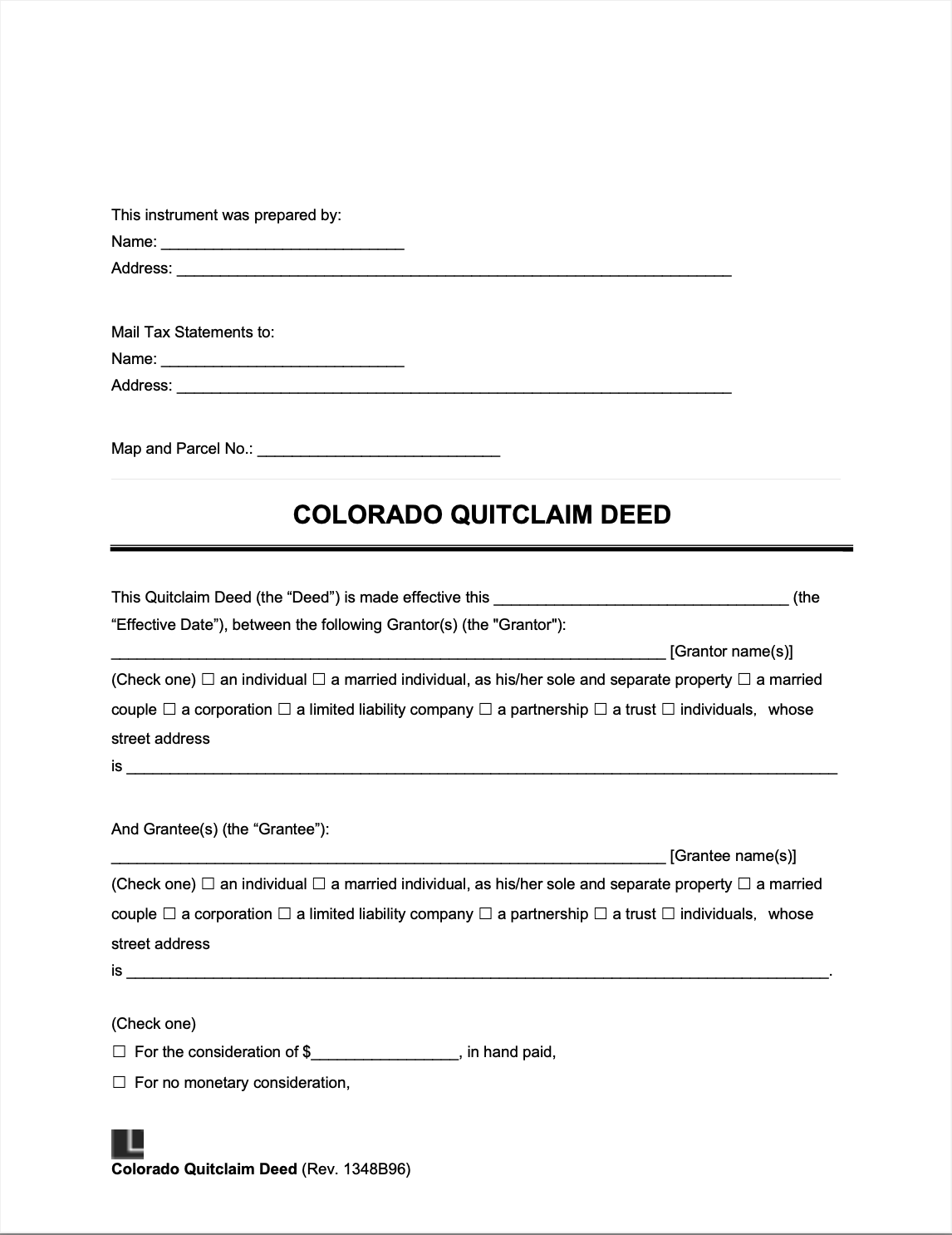In Colorado, quitclaim deeds facilitate the transfer of real estate property from a grantor, or seller, to a grantee, or buyer, with no warranty of title or ownership. They can be used to correct errors in existing titles or deeds, convey property transfers between family members or close friends, often with minimal financial exchange, and handle property distribution following a divorce settlement.
Grantors need to follow all the state’s regulations relating to the legal framework for quitclaim deeds, including the content and validity requirements.
Legal Framework
Colorado quitclaim deed laws address form, effect, terminology, taxation, and filing requirements. Colo. Rev. Stat. § 38-30-113 establishes the form and effect of property deeds, including quitclaim deeds.
According to Colo. Rev. Stat. § 38-30-107, any deed is deemed to convey the property’s full interest unless the grantor explicitly indicates that it is for a portion of the property. So, if your quitclaim transfer is for an interest in a real estate property, be sure to indicate the form and value of that interest.
Legal Description
Every deed transferring real estate must include a legal description of the property being conveyed. The Colorado Department of Local Affairs Division of Property Taxation outlines the standards and methods used to create legal land descriptions:
- US Governmental Survey System.
- Base lines and principal meridians.
- Townships and sections.
- Metes and bounds.
- Lot and block descriptions.
- Colorado Coordinate System.
The legal description should be on the original deed. If you require a new legal description, a registered land surveyor may be able to provide assistance.
Signing
- The current owner, or grantor, must sign the quitclaim deed and acknowledge it before a notary or other authorized individual, pursuant to Colo. Rev. Stat. § 38-35-104.
- If the property is a homestead owned by a married person, as defined under Colo. Rev. Stat. § 38-35-118, both spouses must execute the deed. This only applies if one of the spouses has previously recorded a homestead declaration, per Colo. Rev. Stat. § 38-41-202.
Terminology
- State law provides statutory quitclaim deed language under Colo. Rev. Stat. § 38-30-113. The deed must include the term “quitclaims” instead of “conveys” in the vesting language.
- The form must also include language that states there is no warranty of title.
Additional Documents
You must also submit a Real Property Transfer Declaration (TD-1000), per Colo. Rev. Stat. § 39-14-102. The declaration includes details about the property value and consideration the Colorado Department of Revenue uses to assess property taxes.
Filing
- A quitclaim deed must be filed with the county clerk and recorder for the county where the real property is situated, per Colo. Rev. Stat. § 38-35-106.
- Each deed is subject to statutory recording fees per Colo. Rev. Stat. § 30-1-103 and Colo. Rev. Stat. § 30-10-421.
- In addition, you may owe a real estate tax called a documentary fee for consideration over $500, per Colo. Rev. Stat. § 39-13-102.
Validity Requirements
Colorado has very few formatting standards for a quitclaim deed to be valid for recording.
- Per Colo. Rev. Stat. § 30-10-406, the deed must have a top margin of at least 1 in. and side and bottom margins of at least ½ in.
- The document must also be legible and easy to copy or record digitally. This typically means using white paper with dark print or text large enough to be easily readable.
Content Requirements
When submitting a quitclaim deed form, it must contain the following information:
- Grantor and grantee names and addresses.
- The legal description of the property.
- Identifying info for legal description preparer.
- Vesting information and consideration.
Quitclaim Deeds vs. Other Property Transfer Methods
| Quitclaim Deed | Conveys real estate property from the grantor without guarantee of ownership or title. The grantee becomes responsible for any title defects or ownership problems that arise. |
| General Warranty Deed | Transfers real estate with a full warranty of ownership and title. In the event a title defect arises after the conveyance, the grantor is responsible for correcting it. |
| Special Warranty Deed | Conveys real estate with a warranty of title and ownership limited to the time the current owner owned the premises. |
| Beneficiary Deed | Also called a transfer-on-death (TOD) deed, it allows the property owner to automatically transfer the real estate to a beneficiary upon the owner’s death. |
| Title Insurance | Enables a grantee to reduce financial liability. This coverage also provides some protection against title issues and defects in exchange for an initial premium payment. |
| Bargain and Sale Deed | Acts similar to a quitclaim deed, but also transfers to the grantee any additional interests in the conveyed real estate the grantor receives after the initial transfer. |
